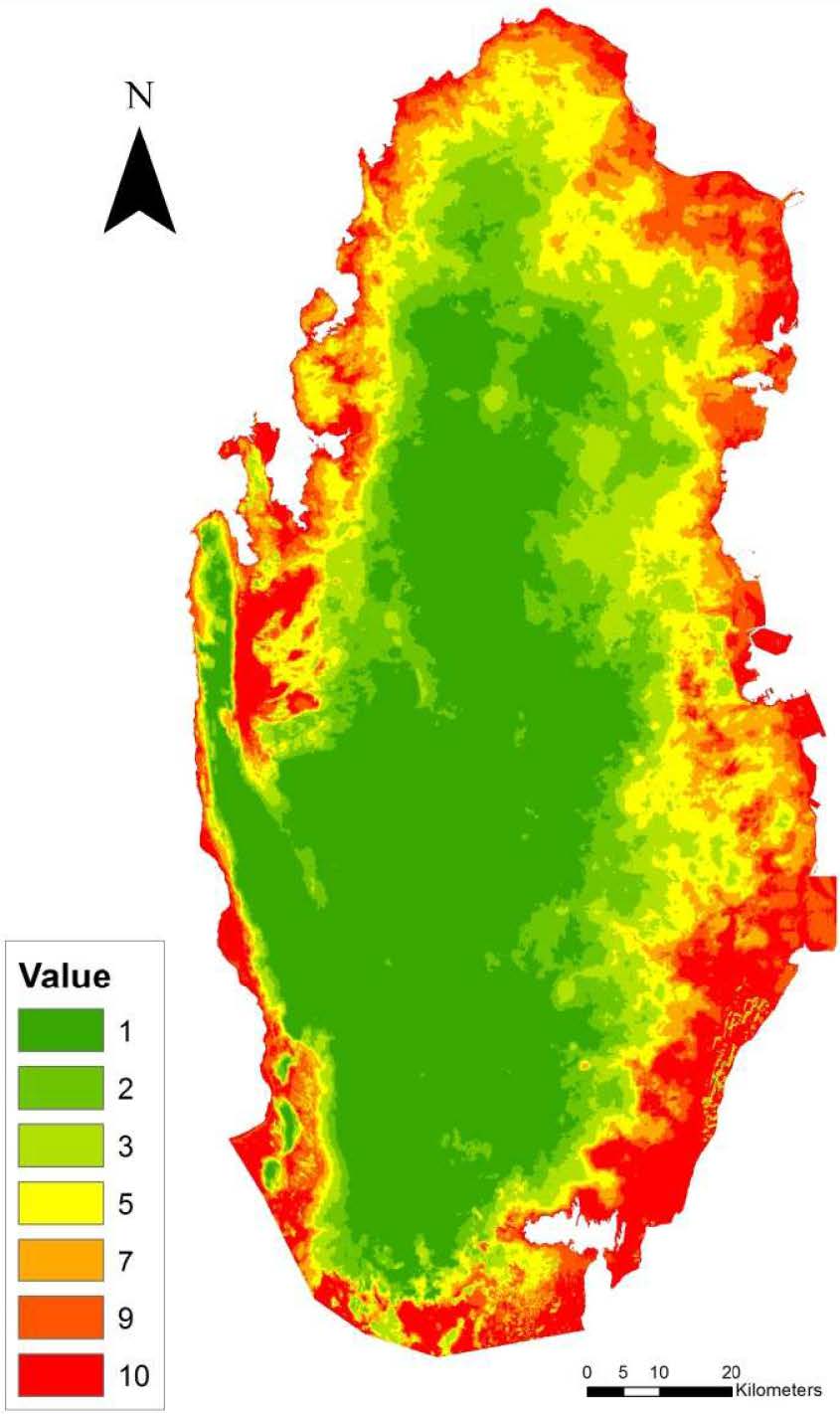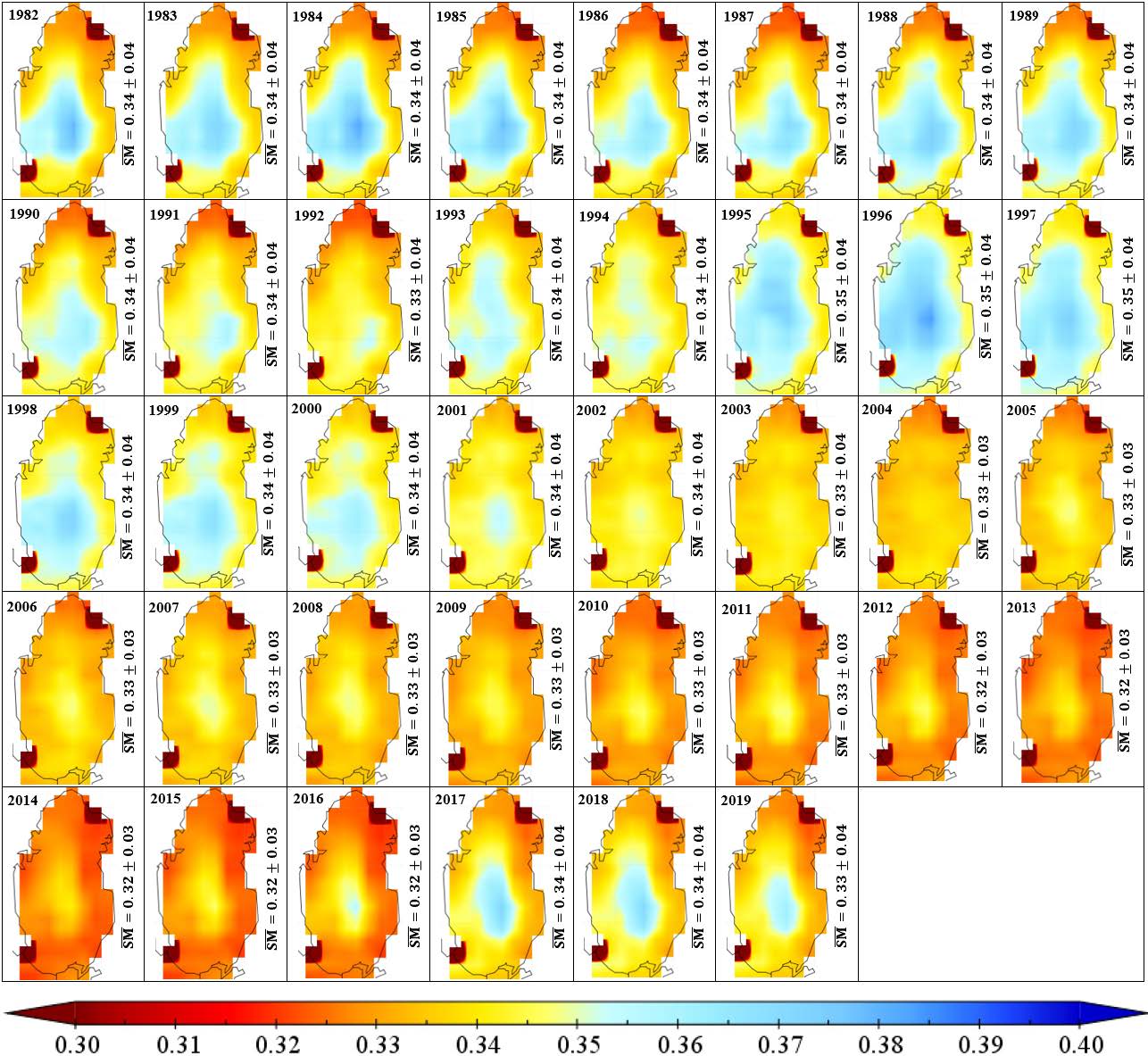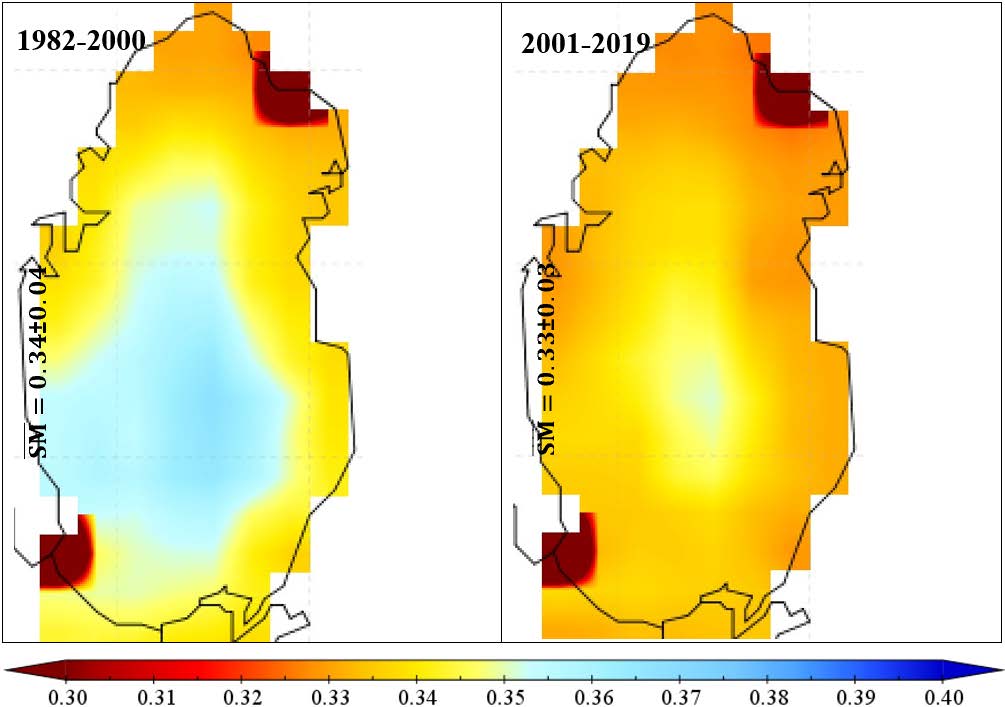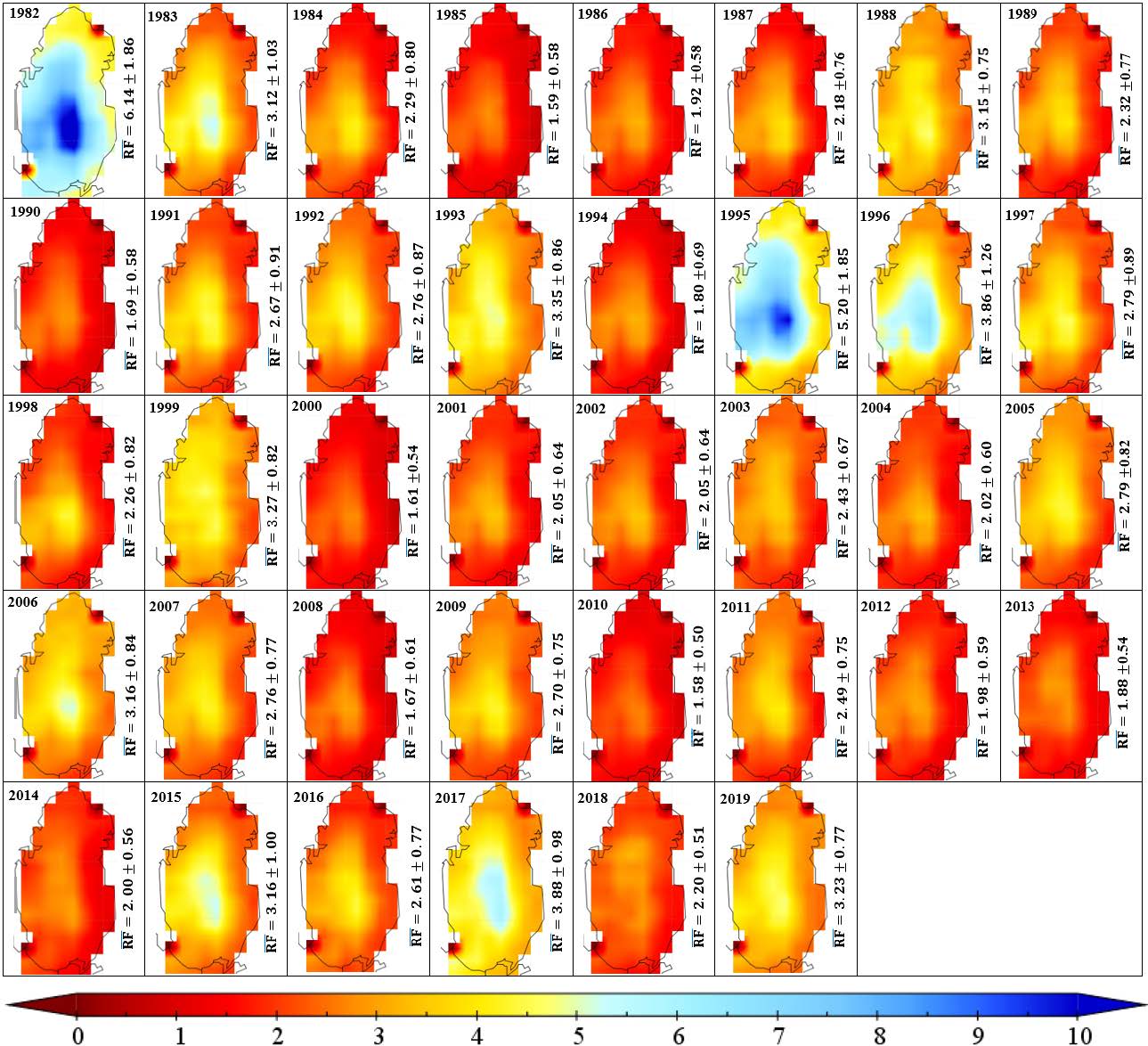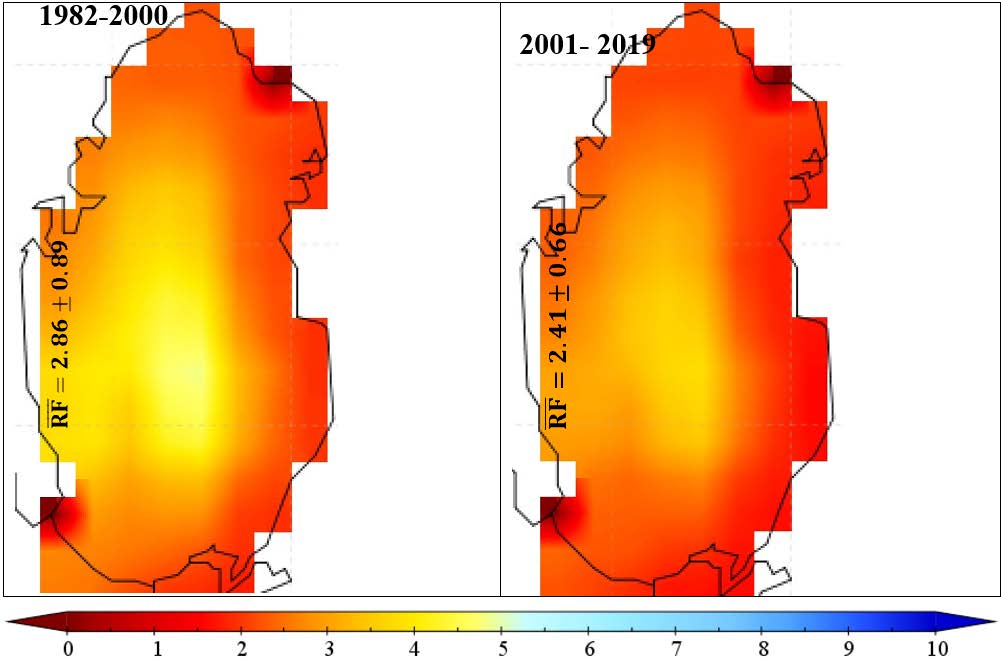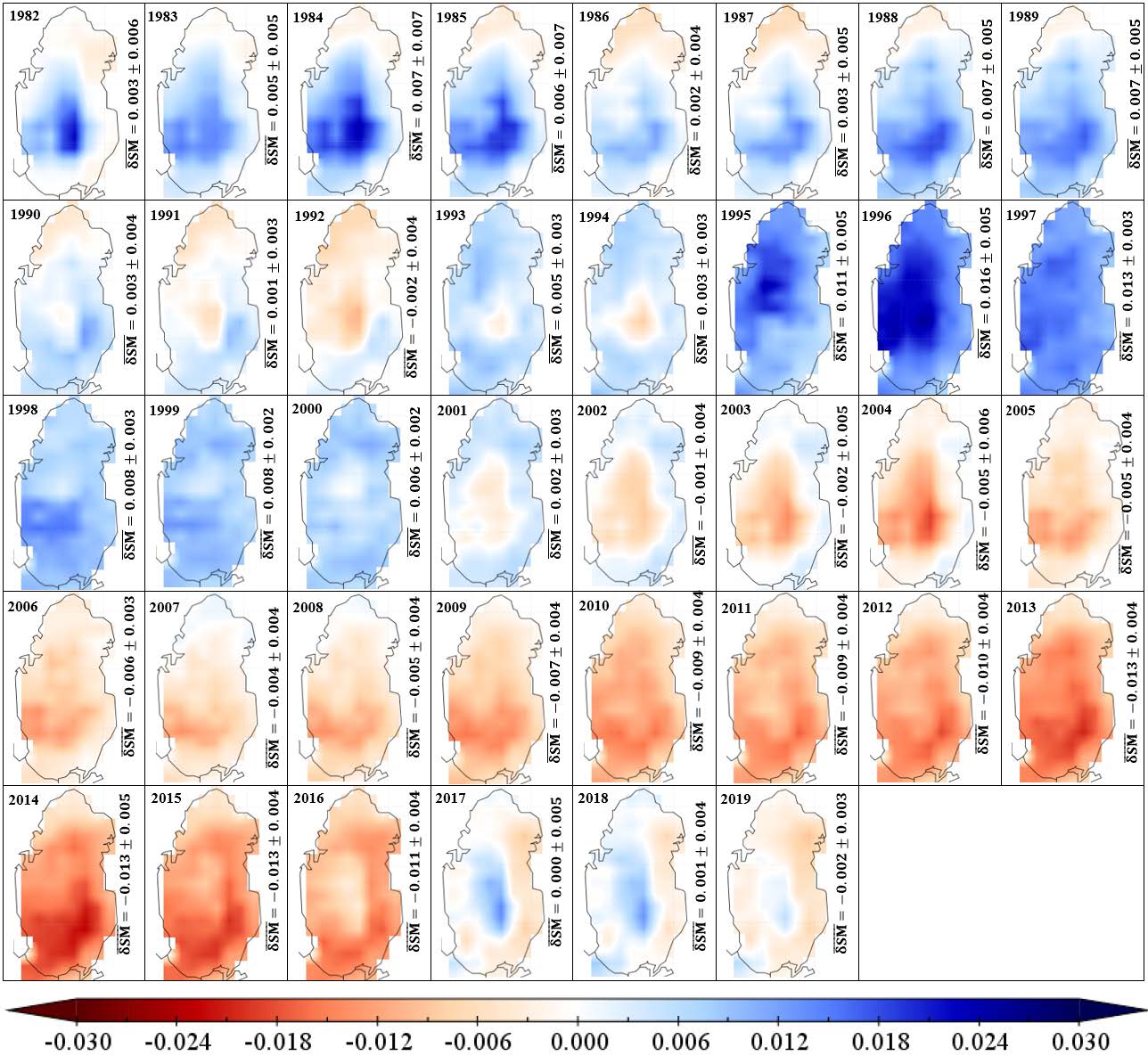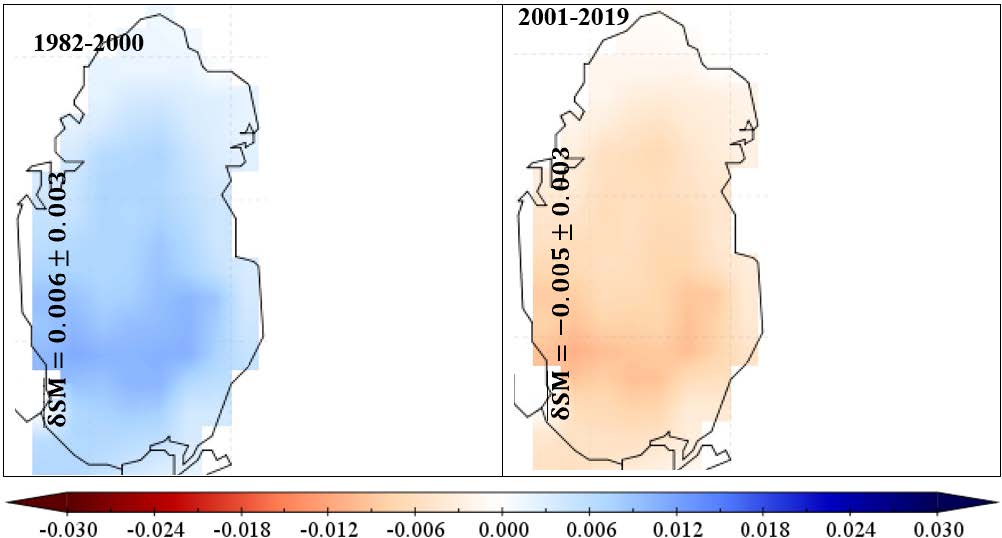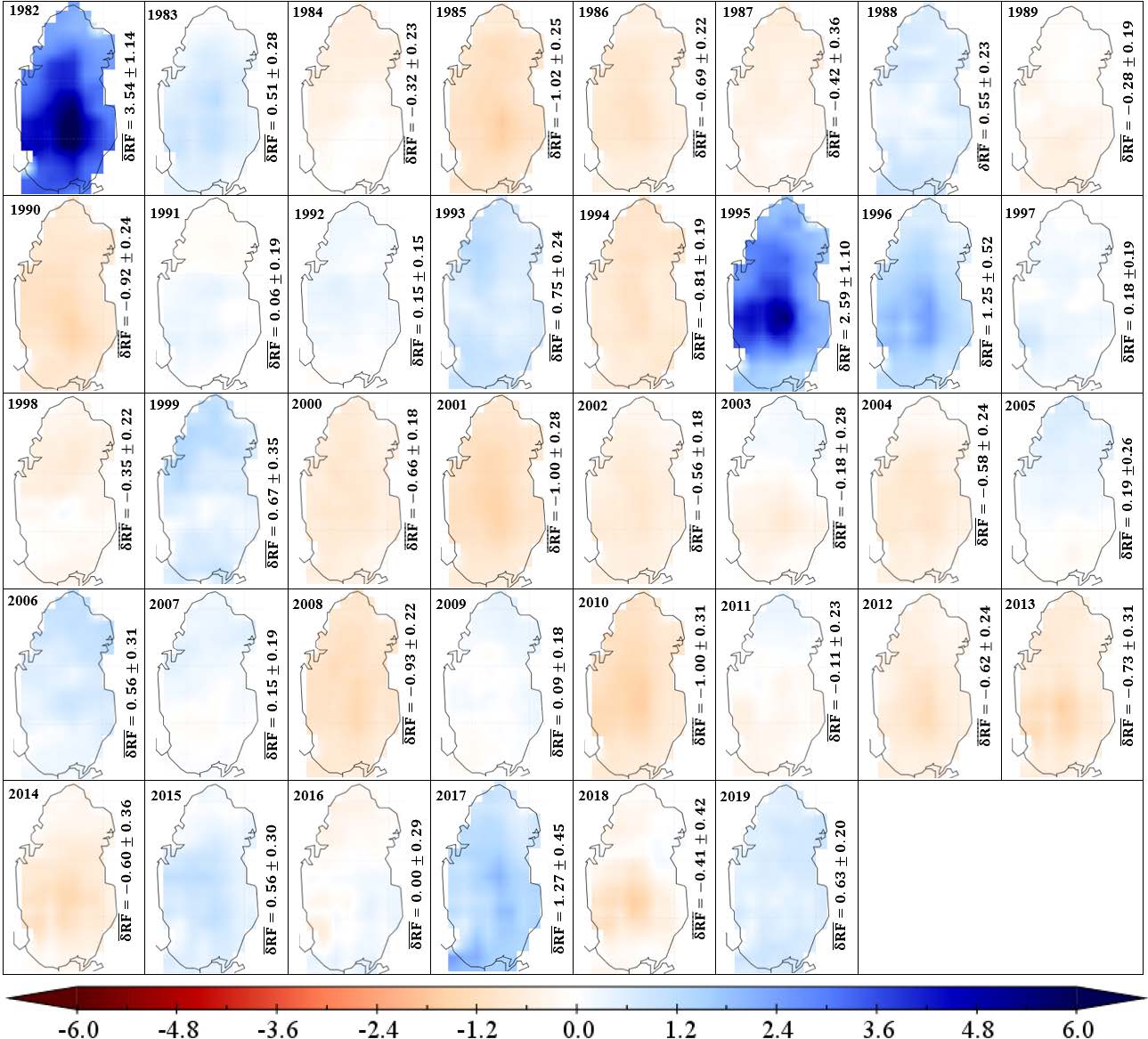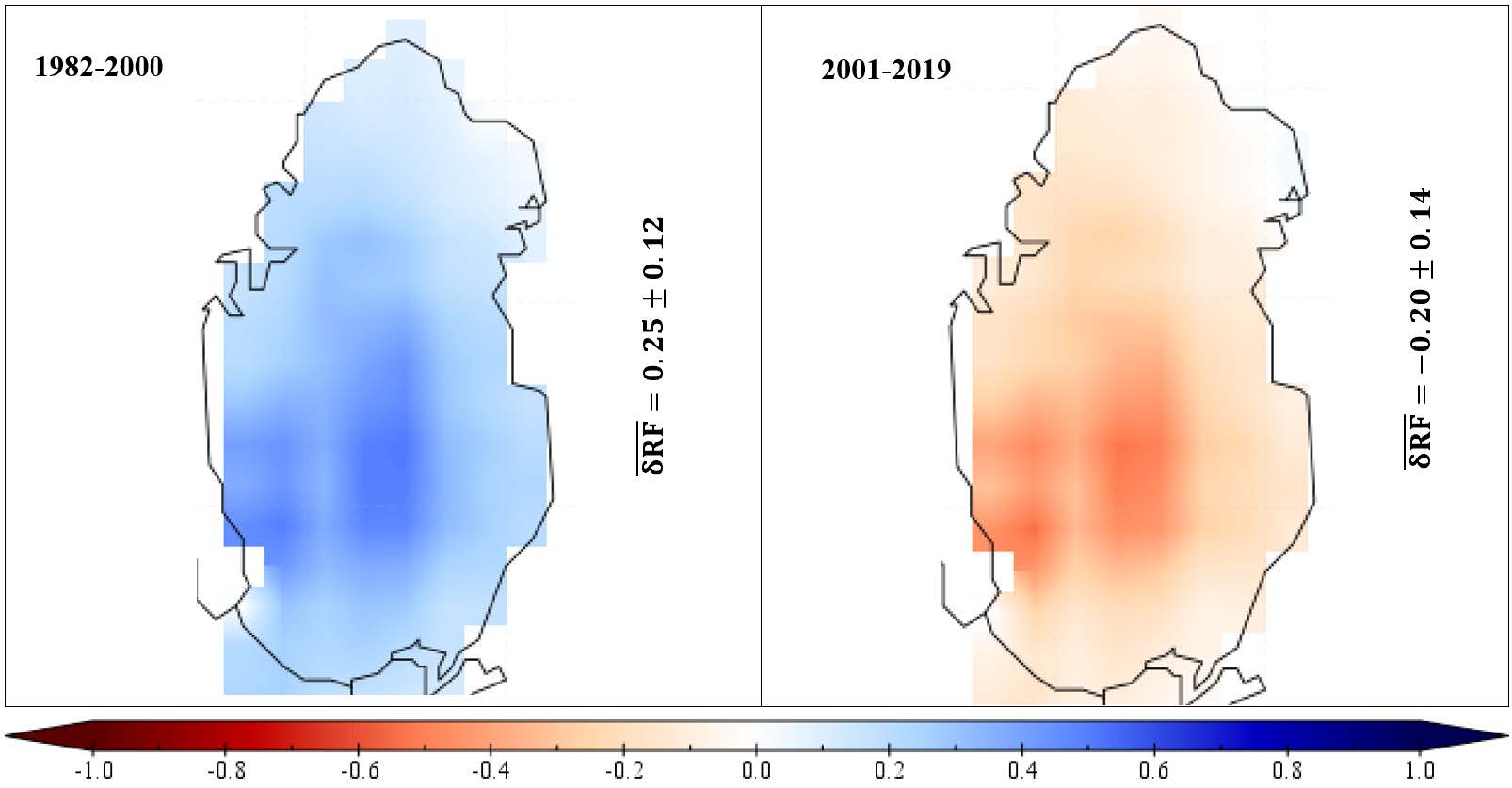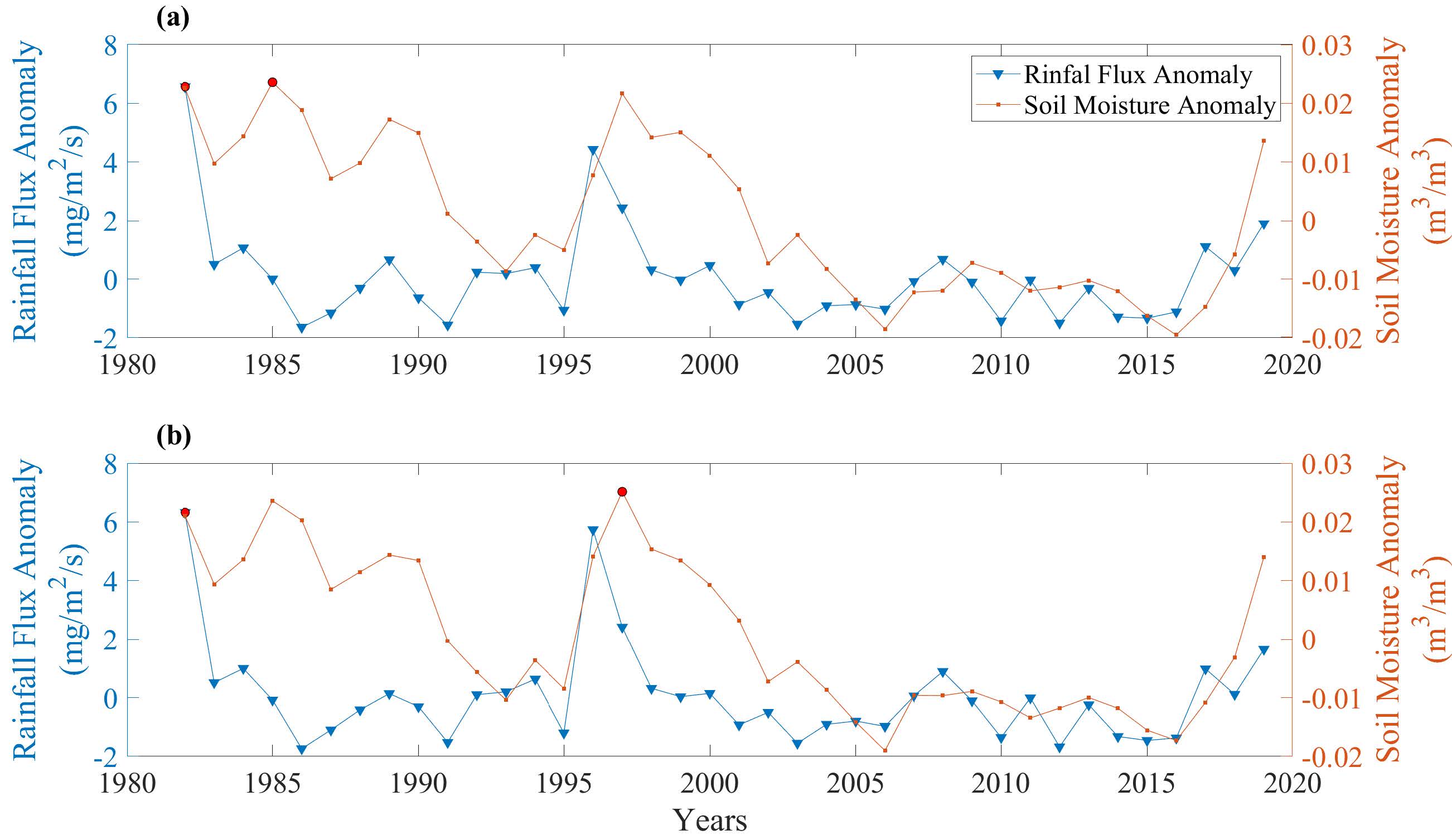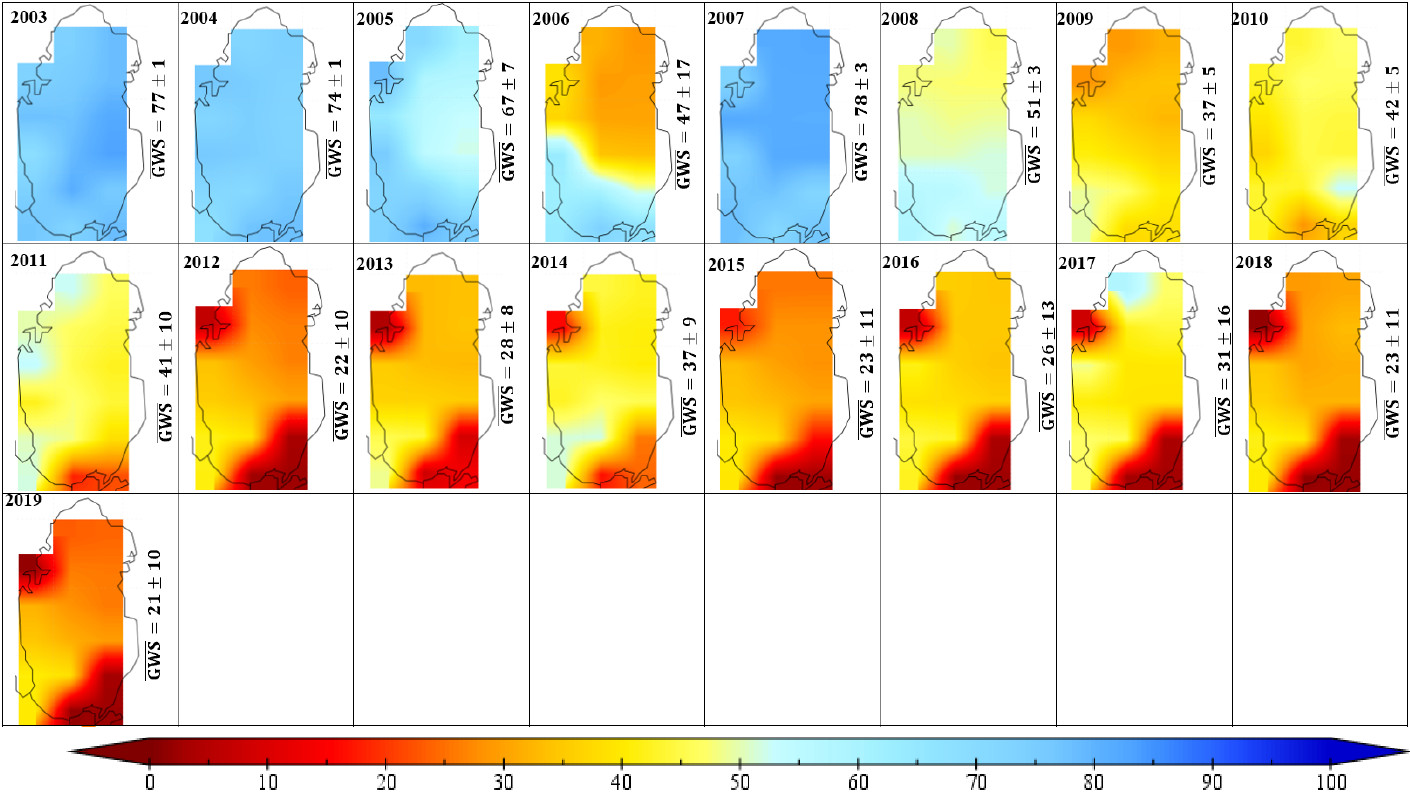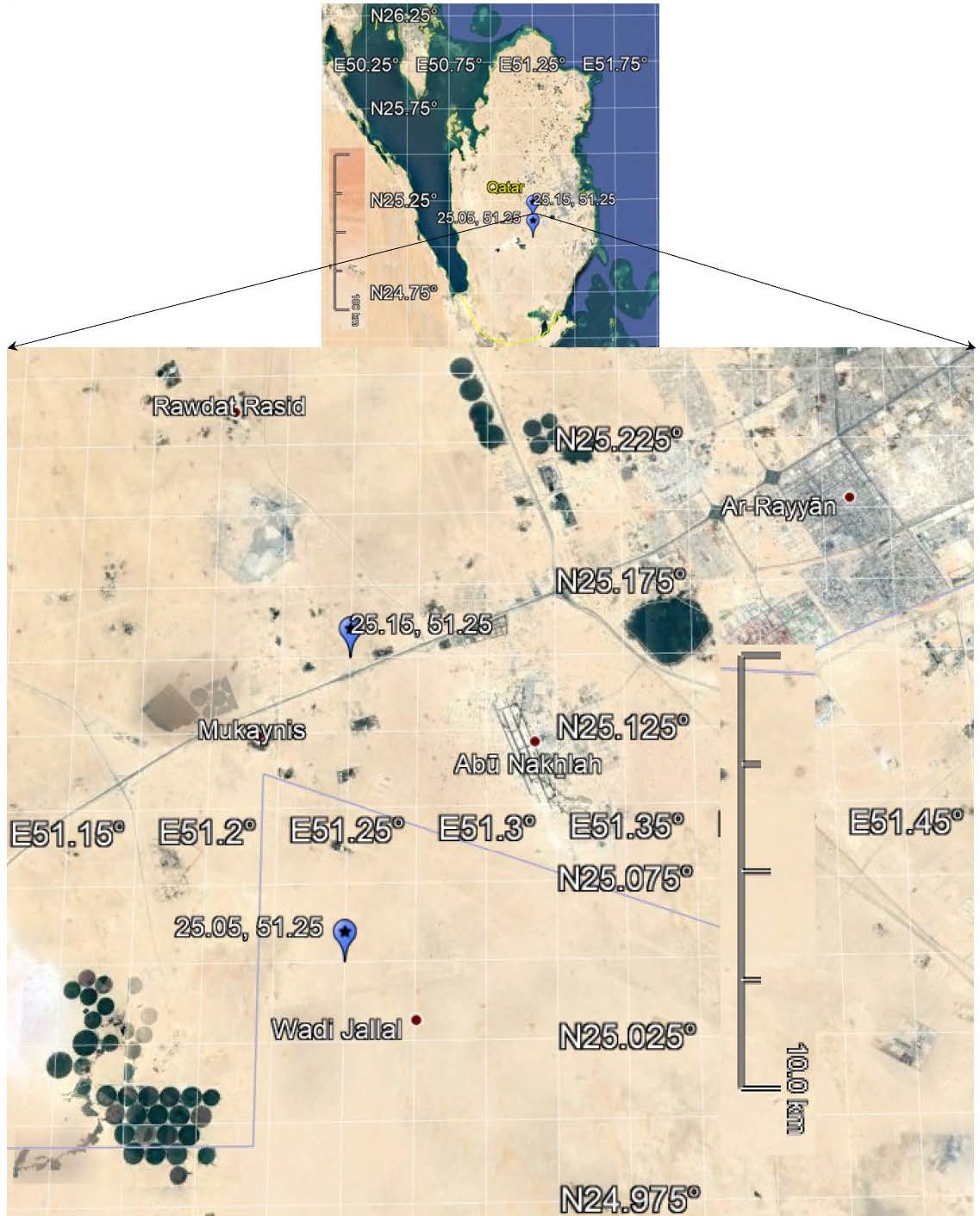Article Peer-Reviewed
Annual Trends of Soil Moisture and Rainfall Flux in an Arid Climate Using Remote Sensing Data
1
Department of Engineering and Engineering Technology, Metropolitan State University of Denver, Denver, CO 80217, USA
2
Department of Civil and Environmental Engineering and Water Resources Research Center, University of Hawaii at Manoa, Honolulu, HI 96822, USA
3
Viterbi School of Engineering, University of Southern California, Los Angeles, CA 90089, USA
4
Jet Propulsion Laboratory, California Institute of Technology, Pasadena, CA 91109, USA
*
For correspondence.
Academic Editor:
 Hossein Bonakdari
Hossein Bonakdari
Received: 1 July 2022 Accepted: 17 August 2022 Published: 18 August 2022
Abstract
The water crisis is still a major issue in Qatar. Seawater desalination has been strongly implemented in the Persian Gulf region. However, it is costly and there is corrosion in piping materials and other equipment. Hence, there is a vital need to detect groundwater resources in Qatar. Various factors affect the variability of groundwater in Qatar including hydrogeological aspects, climate change, drawdown and abstraction, rainwater harvesting, desertification, and population growth. In this study, we employ the Famine Early Warning Systems Network (FEWS NET) Land Data Assimilation System (FLDAS) to monitor annual variations of soil moisture (SM) in the depth of 1–2 m (as an indicator of groundwater) and rainfall flux (RF) from 1982 to 2019. The results show that SM and RF anomalies were positive from 1982 to 2000 (except 1992). In contrast, these anomalies became negative during 2001–2019 (expect 2001 and 2018), implying the drawdown of groundwater resources. Drier years (i.e., negative RF anomaly) in the recent 19 years (2001–2019) reduced SM and led to a negative SM anomaly. The Mukaynis and Wadi Jallal regions (located in Al Rayyan and Al Wakrah municipalities, respectively) had the highest RF and SM from 1982 to 2019. The center-pivot irrigation systems close to the Mukaynis and Wadi Jallal regions indicate their accessibility to groundwater resources in Qatar. Moreover, these regions have the lowest risk of salinization and groundwater vulnerability. In addition, annual trends of groundwater storage (GWS) retrieved from the Gravity Recovery and Climate Experiment (GRACE) from 2003 to 2019 have been presented. This study is beneficial for detecting and monitoring groundwater resources for the sustainable management of water resources in arid environments.
Figures in this Article
Keywords
Qatar; groundwater; soil moisture; rainfall; arid regions; sustainable systems engineering; GRACE; annual anomaly; FLDAS
Copyright © 2022
Valipour et al. This article is distributed under the terms of the Creative Commons Attribution License (CC BY 4.0), which permits unrestricted use and distribution provided that the original work is properly cited.
Cite this Article
ACS Style
Valipour, M.; Khoshkam, H.; Bateni, S.M.; Heggy, E. Annual Trends of Soil Moisture and Rainfall Flux in an Arid Climate Using Remote Sensing Data. Highlights Sustain. 2022, 1, 171–187. https://doi.org/10.54175/hsustain1030013
APA Style
Valipour, M., Khoshkam, H., Bateni, S. M., & Heggy, E. (2022). Annual Trends of Soil Moisture and Rainfall Flux in an Arid Climate Using Remote Sensing Data. Highlights of Sustainability, 1(3), 171–187. https://doi.org/10.54175/hsustain1030013
References
1.
Awadh, S.M.; Al-Mimar, H.; Yaseen, Z.M. Groundwater availability and water demand sustainability over the upper mega aquifers of Arabian Peninsula and west region of Iraq. Environ. Dev. Sustain. 2021, 23, 1–21. https://doi.org/10.1007/s10668-019-00578-z
2.
Schulz, S. Experimental and numerical studies on the water balance of the Upper Mega Aquifer system, Arabian Peninsula. Ph.D. Thesis, Technische Universität Darmstadt, Darmstadt, Germany, 24 March 2017.
3.
Pike, J.G. Groundwater resources development and the environment in the central region of the Arabian Gulf. Int. J. Water Resour. Dev. 1983, 1, 115–132. https://doi.org/10.1080/07900628308722280
4.
Baalousha, H.M.; Ouda, O.K.M. Domestic water demand challenges in Qatar. Arab. J. Geosci. 2017, 10, 537. https://doi.org/10.1007/s12517-017-3330-4
5.
Al-Ibrahim, A.A. Excessive Use of Groundwater Resources in Saudi Arabia: Impacts and Policy Options. Ambio 1991, 20, 34–37.
6.
Bakiewicz, W.; Milne, D.M.; Noori, M. Hydrogeology of the Umm Er Radhuma aquifer, Saudi Arabia, with reference to fossil gradients. Q. J. Eng. Geol. Hydrogeol. 1982, 15, 105–126. https://doi.org/10.1144/GSL.QJEG.1982.015.02.03
7.
Beaumont, P. Water and development in Saudi Arabia. Geogr. J. 1977, 143, 42–60. https://doi.org/10.2307/1796674
8.
Dirks, H.; Al Ajmi, H.; Kienast, P.; Rausch, R. Hydrogeology of the Umm Er Radhuma Aquifer (Arabian peninsula). Grundwasser 2018, 23, 5–15. https://doi.org/10.1007/s00767-017-0388-6
9.
Al-Fatlawi, A.N. Hydrogeological study for Umm Er Radhuma Aquifer—West of Iraq. Ph.D. Thesis, Baghdad University, Baghdad, Iraq, 2010.
10.
Al-Fatlawi, A.N. Geological and hydrogeological characteristics of Umm Er Radhuma aquifer West of Iraq. Euphrates J. Agric. Sci. 2010, 2, 12–20.
11.
Koohafkan, A.P. Desertification, drought and their consequences. Environmental and Natural Resources Service Sustainable Development Department, Food and Agriculture Organization (FAO): Rome, Italy, 1996.
12.
Raghavendra, N.S.; Deka, P.C. Sustainable development and management of groundwater resources in mining affected areas: A review. Procedia Earth Planet. Sci. 2015, 11, 598–604. https://doi.org/10.1016/j.proeps.2015.06.061
13.
Sayl, K.N.; Muhammad, N.S.; Yaseen, Z.M.; El-shafie, A. Estimation the Physical Variables of Rainwater Harvesting System Using Integrated GIS-Based Remote Sensing Approach. Water Resour. Manag. 2016, 30, 3299–3313. https://doi.org/10.1007/s11269-016-1350-6
14.
Almazroui, M.; Saeed, F.; Saeed, S.; Islam, M.N.; Ismail, M.; Klutse, N.A.B.; Siddiqui, M.H. Projected Change in Temperature and Precipitation Over Africa from CMIP6. Earth Syst. Environ. 2020, 4, 455–475. https://doi.org/10.1007/s41748-020-00161-x
15.
Ghorbani, M.A.; Deo, R.C.; Yaseen, Z.M.; Kashani, M.H.; Mohammadi, B. Pan evaporation prediction using a hybrid multilayer perceptron-firefly algorithm (MLP-FFA) model: case study in North Iran. Theor. Appl. Climatol. 2018, 133, 1119–1131. https://doi.org/10.1007/s00704-017-2244-0
16.
Qutbudin, I.; Shiru, M.S.; Sharafati, A.; Ahmed, K.; Al-Ansari, N.; Yaseen, Z.M.; Shahid, S.; Wang, X. Seasonal Drought Pattern Changes Due to Climate Variability: Case Study in Afghanistan. Water 2019, 11, 1096. https://doi.org/10.3390/w11051096
17.
Salih, S.Q.; Allawi, M.F.; Yousif, A.A.; Armanuos, A.M.; Saggi, M.K.; Ali, M.; Shahid, S.; Al-Ansari, N.; Yaseen, Z.M.; Chau, K.-W. Viability of the advanced adaptive neuro-fuzzy inference system model on reservoir evaporation process simulation: Case study of Nasser Lake in Egypt. Eng. Appl. Comput. Fluid Mech. 2019, 13, 878–891. https://doi.org/10.1080/19942060.2019.1647879
18.
Odhiambo, G.O. Water scarcity in the Arabian Peninsula and socio-economic implications. Appl. Water Sci. 2017, 7, 2479–2492. https://doi.org/10.1007/s13201-016-0440-1
19.
Kalhor, K.; Emaminejad, N. Sustainable development in cities: Studying the relationship between groundwater level and urbanization using remote sensing data. Groundw. Sustain. Dev. 2019, 9, 100243. https://doi.org/10.1016/j.gsd.2019.100243
20.
Lanjwani, M.F.; Khuhawar, M.Y.; Jahangir Khuhawar, T.M.; Lanjwani, A.H.; Jagirani, M.S.; Kori, A.H.; Rind, I.K.; Khuhawar, A.H.; Dodo, J.M. Risk assessment of heavy metals and salts for human and irrigation consumption of groundwater in Qambar city: A case study. Geol. Ecol. Lands. 2020, 4, 23–39. https://doi.org/10.1080/24749508.2019.1571670
21.
Bedaso, Z.K.; Wu, S.-Y.; Johnson, A.N.; McTighe, C. Assessing groundwater sustainability under changing climate using isotopic tracers and climate modelling, southwest Ohio, USA. Hydrol. Sci. J. 2019, 64, 798–807. https://doi.org/10.1080/02626667.2019.1606429
22.
Das, B.; Pal, S.C. Assessment of groundwater recharge and its potential zone identification in groundwater-stressed Goghat-I block of Hugli District, West Bengal India. Environ. Dev. Sustain. 2020, 22, 5905–5923. https://doi.org/10.1007/s10668-019-00457-7
23.
Niaz, A.; Khan, M.R.; Ijaz, U.; Yasin, M.; Hameed, F. Determination of groundwater potential by using geoelectrical method and petrographic analysis in Rawalakot and adjacent areas of Azad Kashmir, sub-Himalayas, Pakistan. Arab. J. Geosci. 2018, 11, 468. https://doi.org/10.1007/s12517-018-3811-0
24.
Pande, C.B.; Moharir, K.N.; Singh, S.K.; Varade, A.M. An integrated approach to delineate the groundwater potential zones in Devdari watershed area of Akola district, Maharashtra, Central India. Environ. Dev. Sustain. 2020, 22, 4867–4887. https://doi.org/10.1007/s10668-019-00409-1
25.
Awad, S.R. Groundwater hydrogeology and quality in Helwan area and its vicinities in Egypt. Water Sci. 2019, 33, 10–21. https://doi.org/10.1080/11104929.2019.1624307
26.
Ali, M.E.; Abdel-Hameed, M. The potential of nitrate removal from groundwater of Bani-Suif west area, Egypt using nanocomposite reverse osmosis membranes. J. Bas. Environ. Sci. 2018, 5, 230–239.
27.
Chowdhury, S.; Al-Zahrani, M. Characterizing water resources and trends of sector wise water consumptions in Saudi Arabia. J. King Saud Univ. Eng. Sci. 2015, 27, 68–82. https://doi.org/10.1016/j.jksues.2013.02.002
28.
Taylor, R.; Scanlon, B.; Döll, P.; Rodell, M.; van Beek, R.; Wada, Y.; Longuevergne, L.; Leblanc, M.; Famiglietti, J.S. Ground water and climate change. Nature Clim. Change 2013, 3, 322–329. https://doi.org/10.1038/nclimate1744
29.
Lezzaik, K.; Milewski, A.; Mullen, J. The groundwater risk index: development and application in the Middle East and North Africa region. Sci. Total Environ. 2018, 628, 1149–1164. https://doi.org/10.1016/j.scitotenv.2018.02.066
30.
Hussein, H.; Lambert, L.A. A Rentier State under Blockade: Qatar’s Water-Energy-Food Predicament from Energy Abundance and Food Insecurity to a Silent Water Crisis. Water 2020, 12, 1051. https://doi.org/10.3390/w12041051
31.
Al Hajri, M.M.; Shadid, F.T.; Al-Hajri, K.; Ahmed, S. Qualitative and quantitative assessment of drained water from urban ground-water. Eng. J. Qatar Univ. 1992, 5, 237–248.
32.
Ministry of Development Planning and Statistics (MDPS). Water Statistics in the State of Qatar 2015; Ministry of Development Planning and Statistics: Doha, Qatar, 2017.
33.
Ministry of Development Planning and Statistics (MDPS). Water Statistics in the State of Qatar, Doha; Ministry of Development Planning and Statistics: Doha, Qatar, 2018.
34.
Baalousha, H.M. Groundwater vulnerability mapping of Qatar aquifers. J. Afr. Earth Sci. 2016, 124, 75–93. https://doi.org/10.1016/j.jafrearsci.2016.09.017
35.
Sadiq A.M.; Nasir S.J. Middle Pleistocene karst evolution in the State of Qatar, Arabian Gulf. J. Cave Karst Stud. 2002, 64, 132–139.
36.
Giorgi, F. Climate change hot-spots. Geophys. Res. Lett. 2006, 33, 1–4. https://doi.org/10.1029/2006GL025734
37.
Dee, D.P.; Uppala, S.M.; Simmons, A.J.; Berrisford, P.; Poli, P.; Kobayashi, S.; Andrae, U.; Balmaseda, M.A.; Balsamo, G.; Bauer, P.; et al. The ERAInterim reanalysis: Configuration and performance of the data assimilation system. Q. J. R. Meteorol. Soc. 2011, 137, 553–597. https://doi.org/10.1002/qj.828
38.
Solomon, S.; Manning, M.; Marquis, M.; Qin, D. Climate change 2007-the physical science basis: Working group I contribution to the fourth assessment report of the IPCC (Vol. 4). Cambridge University Press: Cambridge, UK, 2007.
39.
McNally, A.; Arsenault, K.; Kumar, S.; Shukla, S.; Peterson, P.; Wang, S.; Funk, C.; Peters-Lidard, C.D.; Verdin, J.P. A land data assimilation system for sub-Saharan Africa food and water security applications. Sci. Data 2017, 4, 170012. https://doi.org/10.1038/sdata.2017.12
40.
Morris, J.D.; Collopy, J.J. Water use and salt accumulation by Eucalyptus camaldulensis and Casuarina cunninghamiana on a site with shallow saline groundwater. Agric. Water Manag. 1999, 39, 205–227. https://doi.org/10.1016/S0378-3774(98)00079-1
41.
Harvey, J.W.; Odum, W.E. The influence of tidal marshes on upland groundwater discharge to estuaries. Biogeochemistry 1990, 10, 217–236. https://doi.org/10.1007/BF00003145
42.
Vadas, P.A.; Srinivasan, M.S.; Kleinman, P.J.A.; Schmidt, J.P.; Allen, A.L. Hydrology and groundwater nutrient concentrations in a ditch-drained agroecosystem. J. Soil Water Conserv. 2007, 62, 178–188.
43.
Xia, M.; Ma, L.; Shi, Q.; Chen, Z.; Zhou, J. The Relationship of NO3--N Leaching and Rainfall Types During Summer Fallow in the Loess Plateau Dryland. Sci. Agric. Sin. 2018, 51, 1537–1546. https://doi.org/10.3864/j.issn.0578-1752.2018.08.010
44.
Sarkar, T.; Kannaujiya, S.; Taloor, A.K.; Ray, P.K.C.; Chauhan, P. Integrated study of GRACE data derived interannual groundwater storage variability over water stressed Indian regions. Groundw. Sustain. Dev. 2020, 10, 100376. https://doi.org/10.1016/j.gsd.2020.100376
45.
Diouf, O.C.; Weihermüller, L.; Diedhiou, M.; Vereecken, H.; Faye, S.C.; Faye, S.; Sylla, S.N. Modelling groundwater evapotranspiration in a shallow aquifer in a semi-arid environment. J. Hydrol. 2020, 587, 124967. https://doi.org/10.1016/j.jhydrol.2020.124967
46.
Wang, S.; Liu, H.; Yu, Y.; Zhao, W.; Yang, Q.; Liu, J. Evaluation of groundwater sustainability in the arid Hexi Corridor of Northwestern China, using GRACE, GLDAS and measured groundwater data products. Sci. Total Environ. 2020, 705, 135829. https://doi.org/10.1016/j.scitotenv.2019.135829
47.
Hameed, M.; Ahmadalipour, A.; Moradkhani, H. Drought and food security in the middle east: An analytical framework. Agric. For. Meteorol. 2020, 281, 107816. https://doi.org/10.1016/j.agrformet.2019.107816
48.
Valipour, M.; Bateni, S.M.; Gholami Sefidkouhi, M.A.; Raeini-Sarjaz, M.; Singh, V.P. Complexity of forces driving trend of reference evapotranspiration and signals of climate change. Atmosphere 2020, 11, 1081. https://doi.org/10.3390/atmos11101081
49.
Valipour, M.; Sefidkouhi, M.A.G.; Raeini-Sarjaz, M. Selecting the best model to estimate potential evapotranspiration with respect to climate change and magnitudes of extreme events. Agric. Water Manag. 2017, 180, 50–60. https://doi.org/10.1016/j.agwat.2016.08.025
50.
Ellis, M. Caves in Qatar. SMCC J. 2004, 13, 324–331.
51.
The Centre for Geographic Information Systems of Qatar. http://geoportal.gisqatar.org.qa/qmape/index.html. Retrieved 4 January 2019. https://en.wikipedia.org/wiki/Wadi_Jallal (assessed 22 July 2020).
52.
Grichting, A. Blue Design for Urban Resilience in Drylands: The Case of Qatar. In Nature Driven Urbanism; Roggema, R., Ed.; Springer: Cham, Switzerland, 2020; pp. 175–208.
53.
Ahmad, A.Y.; Al-Ghouti, M.A. Approaches to achieve sustainable use and management of groundwater resources in Qatar: A review. Groundw. Sustain. Dev. 2020, 11, 100367. https://doi.org/10.1016/j.gsd.2020.100367
54.
Lee, J.J.; O’Neill, I.J. US-Qatar Partnership Aims to Find Buried Water in Earth’s Deserts. Available online: https://climate.nasa.gov/news/3024/us-qatar-partnership-aims-to-find-buried-water-in-earths-deserts/ (assessed 12 October 2020).
55.
Abotalib, A.Z.; Heggy, E.; Scabbia, G.; Mazzoni, A. Groundwater dynamics in fossil fractured carbonate aquifers in Eastern Arabian Peninsula: A preliminary investigation. J. Hydrol. 2019, 571, 460–470. https://doi.org/10.1016/j.jhydrol.2019.02.013
56.
Heggy, E. Probing groundwater in arid environments: challenges and opportunities south of the Mediterranean basin. Euro-Mediterr. J. Environ. Integr. 2018, 3, 42. https://doi.org/10.1007/s41207-018-0084-7
57.
USDA. Conservation Innovation Grants. Available online: https://www.nrcs.usda.gov/wps/portal/nrcs/detailfull/national/programs/financial/cig/?cid=stelprdb1045412 (assessed 28 October 2020).
58.
Ismail, A.M.A. The quality of irrigation ground-water in Qatar and its effect on the development of agriculture. J. Arid Environ. 1984, 7, 101–106. https://doi.org/10.1016/S0140-1963(18)31405-8
Metrics
Loading...
Journal Menu
Journal Contact
Highlights of Sustainability
Editorial Office
Highlights of Science
Avenida Madrid, 189-195, 3-3
08014 Barcelona, Spain
08014 Barcelona, Spain
Cathy Wang
Managing Editor
